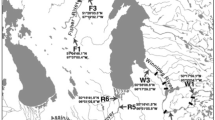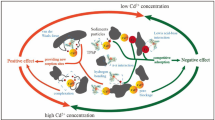Abstract
The mechanisms of adsorption of pesticides(dimethoate, metalaxyl, atrazine, malathion and prometryn) and heavy metals(Cu, Cd, Pb, Zn and Ni) coexisting in sediments, with pesticides as target pollutants, and the influence of their main effects and double-order interaction effects were studied using the experimental design module in the Minitab software package with a 210‒3 fractional factorial design method at resolution V. The main, double-order interaction, synergistic and antagonistic effect values of pollutant concentrations influencing the adsorption of pesticides were set as dependent variables, while various quantum chemical parameters of pesticides were set as independent variables, and two-dimensional quantitative structure activity relationship(2D-QSAR) models were established by stepwise regression to reveal the adsorption mechanisms of pesticides in a composite contamination system. The main effects of pollutants concentration played the primary role in the adsorption of dimethoate and malathion(the rates of contributions were 53.54% and 56.46%, respectively), while double-order interaction effects were primarily responsible for metalaxyl, atrazine and prometryn adsorption(the rates of contributions were 79.05%, 60.21% and 57.89%, respectively) in the pesticide/heavy metals coexisting sediment system. The synergistic effects of the main effects and double-order interaction effects of pollutants concentration(synergistic effects) played a leading role in adsorption of malathion and prometryn(the rates of contributions were 70.61% and 69.61%, respectively), while antagonistic effects of the main effects and double-order interaction effects of pollutants(antagonistic effects) played a dominant role in the adsorption of dimethoate, metalaxyl and atrazine(the rates of contributions were 58.82%, 56.89% and 58.24%, respectively). Moreover, the correlation coefficient value(R2) ranged from 0.986 to 0.999(>0.8783) in the 2D-QSAR model, while the standard deviation(SD) ranged from 0.006 to 0.066 and the F test values were 22.684―199.544, indicating the model has good predictive ability and fit. The 2D-QSAR model revealed a significant correlation(P=0.05) between the main effects of pollutants concentrations on pesticides adsorption(main effect values) and the most positive hydrogen atomic charge(\(q_{H^+}\)), the highest occupied molecular orbital energy(EHOMO) and the dipole moment(μ). Furthermore, double-order interaction effect values of pollutant concentrations influenced the adsorption of pesticides(double-order interaction effect values), and the most positive atomic charge(q+), \(q_{H^+}\), and the lowest occupied molecular orbital energy(ELUMO) were significantly correlated. The qH+, ELUMO and μ of pesticides were found to be significant factors promoting pesticides adsorption, while the q+ and ELUMO of pesticides were significant inhibiting factors(P=0.05). Overall, this study provides a theoretical basis for further realization of combined pollution control of pesticide pollutants in complex environmental systems.
Similar content being viewed by others
References
Gao J. P., Maguhn J., Spitzauer P., Kettrup., Water Res. 1998, 32(7), 2089
Biradar D. P., Rayburn A. L., J. Environ. Qual., 1995, 24(6), 1222
Tao Q., Tang H., Chemosphere 2004, 56(1), 31
Huang Y., Li Z. Y., Zhao B. S., J. Environ. Sci. Manag., 2009, 34(4), 20
Li Q. Q., Zhu Y. W., Xiong M. Y., Duan J., Wu L. J., Li C. Z., Min S. G., Spectrosc. Spect. Anal. 2010, 30(12), 3395
Shi D. R., Zhang L. D., Ren L. P., Yu J. L., Tian X., J. Agro-Environ. Sci., 2006, 25(4), 988
Tao Q. H., Tang H. X., Acta Sci. Circum. 2004, 24(4), 696
Evgenidou E., Bizani E., Christophoridis C., Fytianos K., Chemos-phere 2007, 68(10), 1877
Wang L., Zhang C., Zhong M. J., Qian P., Chem. J. Chinese Univer-sities, 2015, 36(7), 1358
Li Y., Wang A., Gao Q., Wang X. L., Chem. Res. Chinese Universi-ties 2009, 25(1), 31
Jantunen A. P. K., Tuikka A., Akkanen J., Kukkonen J. V. K., Ecotox. Environ. Safe. 2008, 71(3), 860
Wang X., Wang C. R., Zhang L. L., Wu X. S., Wang D. Y., Cai X. D., J. Southwest Univ. Sci. Technol., 2014, 29(3), 40
Gorzerino C., Quemeneur A., Hillenweck A., Baradat M., Delous G., Ollitrault M., Azam D., Caquet T., Lagadic L., Ecotox. Environ. Safe. 2009, 72(3), 802
Fei Y., Yan X. L., Liao X. Y., Li Y. H., Lin L. Y., Shan T. Y., Acta Sci. Circum. 2016, 36(11), 4164
Li H., Zhang H. L., Dong Y. B., Tan Y., Chen S., Liu L. L., Res. En-viron. Sci. 2016, 29(8), 1154
Fan P., Yang J. C., Deng S. H., Jiang H. M., Zhang J. F., Li L. L., Shen F., J. Agro-Environ. Sci., 2011, 30(10), 1925
Wang X. H., Yang H. J., Yan B. H., Tang M. Z., Luo L., Hunan Agric. Sci. 2011, 1, 85
Weng H. X., Zhu Y. M., Qin Y. C., Chen J. Y., Chen X. H., J. Asian Earth Sci., 2008, 31, 522
Gao J. P., Maguhn J., Spitzauer P., Kettrup A., Water Res. 1998, 32(5), 1662
Cheng W. W., Kang C. L., Wang T. T., Li Y. M., Chem. Res. Chinese Universities. 2011, 27(3), 402
Li Y. Q., Jiang H., Lv C. W., Fan M. D., Wang W., Zhang R. Q., Xie Z. L., Wang J. H., Yu B., En H., Ding T., Environ. Sci. 2016, 37(3), 1008
Zhang Y. L., Shi X. C., Zhang R. L., Sichuan Environ. 2002, 21(2), 13
Qian Z., Sun J., Tie B. Q., Mao X. Q., Zhan L. Z., Chin. J. Eco-Agric., 2006, 14(3), 135
Liu B. G., Liu J. W., Li J. Q., Geng S., Mo H. Z., Liang G. Z., Chem. J. Chinese Universities, 2017, 38(1), 41
Wang M. Y., Ma Y., Wang H. Y., Cao G., Li Z. M., Chem. J. Chinese Universities, 2016, 37(9), 1636
Chen Y., Cai X. Y., Jiang L., Li Y., Ecotox. Environ. Safe. 2015, 124, 202
Dong D. M., Nelson Y. M., Lion L. W., Water Res. 2000, 34(2), 427
Ma R. C., Gao Z. T., Chen B. C., Zhao W. J., Wang M., Li Y., Sci. Techn. Eng. 2004, 20(14), 144
Gu W. W., Cheng B. C., Li Y., Pol. J. Environ. Stud., 2017, 26(1), 47
Bailey G. W., White J. L., J. Agr. Food Chem., 1964, 12(4), 324
Senesi N., Sci. Total Environ. 1992, 123, 63
Hayes M. H. B., Pick M. E., Toms B. A., et al., Residue Rev. 1975, 57(1), 25
Anderson R. B., J. Am. Chem. Soc., 1956, 68, 686
Yang C. W., Wang Q. Q., Liu W. P., Environ. Sci. 2002, 21(4), 94
Long J. J., Zhang M. Q., Zhang X., Comput. Appl. Chem. 2005, 22(10), 883
Luo Y. F., Huang J., Yu G., Comput. Appl. Chem. 2009, 26(6), 773
Pei H. P., Xu G. J., J. Zhejiang Univ-Sci., 2003, 30(3), 310
Jiang L., Wen J. Y., Zeng Y. L., Li Y., Asian J. Chem., 2014, 26(22), 575
Yao S. W., Lopes V. H. C., Fernández F, Garcia-Mera X., Morales M., Rodriguez-Borges J. E., Cordeiro M. N. D. S., Bioorg. Med. Chem. 2003, 11(23), 4999
Li G. D., Peng F., Chen L. M., Chen J. C., Zheng K. C., Chem. Res. Appl. 2015, 2, 113
Kaliszan R., J. Chromatogr. A, 1993, 656(1/2), 417
Tao Q. H., Tang H. X., Chemosphere 2004, 56, 31
Author information
Authors and Affiliations
Corresponding author
Additional information
Supported by the Fundamental Research Funds for the Central Universities in 2013, China(No.JB2013146) and the Key Projects in the National Science & Technology Pillar Program in the Eleventh Five-Year Plan Period, China(No.2008BAC43B01).
Rights and permissions
About this article
Cite this article
Wang, X., Li, Q., Li, M. et al. Interference Adsorption Mechanisms of Dimethoate, Metalaxyl, Atrazine, Malathion and Prometryn in a Sediment System Containing Coexisting Pesticides/Heavy Metals Based on Fractional Factor Design(Resolution V) Assisted by 2D-QSAR. Chem. Res. Chin. Univ. 34, 397–407 (2018). https://doi.org/10.1007/s40242-018-7253-8
Received:
Accepted:
Published:
Issue Date:
DOI: https://doi.org/10.1007/s40242-018-7253-8




